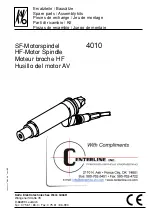
QGroundControl - UDP
1. Open QGroundControl
2. Click on the “Q” in the upper left corner
3. Click on “Comm Links”
4. Click “Add”
5. Select “UDP” as the type
6. Enter a name for your connection
7. Enter the “Write Port” number from the Botlink Tray App in the Listening Port field
8. Under Target Hosts, click Add
9. Enter 127.0.0.1: followed by the “Listen Port” number from the Botlink Tray App
a. Ex: 127.0.0.1:1024
10. Click “OK”
11. Click “Connect”
5 Install the Botlink XRD on your drone
Once the application and Botlink Relay have been configured, it’s time to install the Botlink XRD
on your drone. This process varies depending on the drone, but generally speaking you’ll need
to identify a mounting location on the drone for the Botlink XRD (either with or without
enclosure) and attach the unit, connect the serial cable, connect the power cable, and connect
the antennas.
5.1 Mounting the XRD
Mounting the Botlink XRD is a straightforward process. Customers have used everything from
rubber bands to Velcro to physically attach the Botlink XRD to their drone. When mounting the
Botlink XRD, keep in mind that it requires a connection to the autopilot and power in order to
function. The included power cable is approximately 12 inches long, and the included serial
cable is about 9 inches long. If you’re planning on using your Botlink XRD without the enclosure,
make sure that the unit is protected from dust and moisture. This is most easily accomplished by
mounting the enclosureless unit inside the drone fuselage.
5.2 Connect the serial cable
The serial cable included with the Botlink XRD is a 6-pin DFU cable that is suitable to use when
connecting to a Pixhawk autopilot. Either end of the cable can be connected to either the
autopilot or the XRD.
11










































